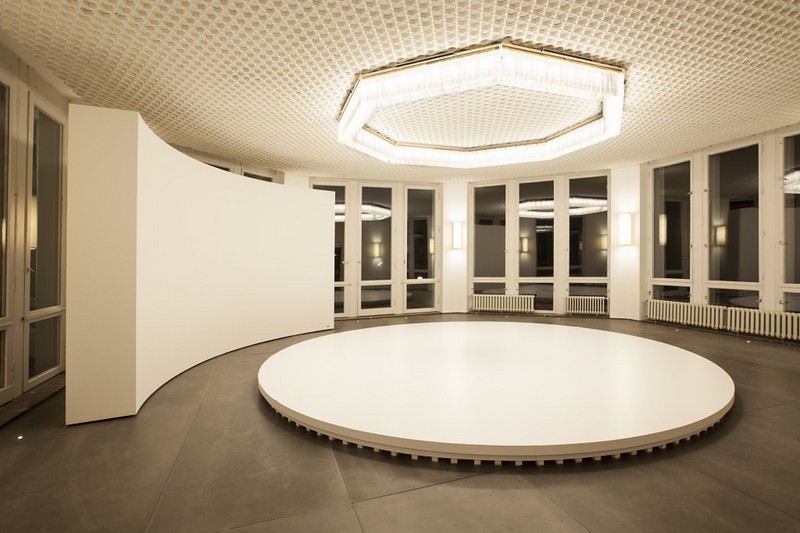Philippe Parreno
15 Nov 2014 - 01 Feb 2015
PHILIPPE PARRENO
How Can We Tell the Dancers from the Dance
15 November 2014 — 1 February 2015
A white dance floor occupies the space of the pavilion from which the ghostly sounds of invisible dancers echo—footsteps and footfalls taken from movements choreographed by the late Merce Cunningham, and performed by dancers of the Merce Cunningham Dance Company.
The floor seems to reverberate with the weight of the phantasmagoric performers yet it remains static and motionless. Around the dance floor a wall is continuously turning. Throughout his practice, Parreno has fundamentally redefined the exhibition experience by exploring its possibilities as a coherent ‘object’ and a medium in its own right rather than as a collection of individual works. To this end, he conceives his shows as a scripted space where a series of events unfolds. How Can We Tell the Dancers from the Dance presents the visitor with a haunting sensory experience.
In its new configuration at the Schinkel Pavillon in Berlin, the work How Can We Know the Dancer from the Dance? resonates with the concentric architectural structure of the glass pavilion and delineates the space’s expanses and proportions by performing a choreography of its own. The eleven dance movements that appear as aural revenants of the dancers’ bodies were recorded in New York in 2012 and were selected from five choreographies by Merce Cunningham: Roaratorio, Suite for Five, XOVER, RainForest, and Duets.
How Can We Know the Dancer from the Dance? was first shown in the 2012 exhibition Dancing around the Bride at the Philadelphia Museum of Art – an exhibition that examined the impact of the work of Marcel Duchamp upon four of the most important American post-war artists: composer John Cage, dancer and choreographer Merce Cunningham, and visual artists Jasper Johns and Robert Rauschenberg.
Like John Cage and Merce Cunningham, Parreno is fascinated by the potential to create structure via the incorporation of random phenomena. Cunningham developed a technique he named ‘choreography by chance,’ whereby random processes, such as the tossing of a coin, were applied to select individual movements and assign sequences. Cunningham considered this to be pure movement, a process that would never have arisen through traditional methods and collaborations. Similarly, in Parreno’s work the method of chance allows the boundaries of the artwork to evolve and change over time, permitting it to almost take on a life of its own.
The exhibition How Can We Tell the Dancers from the Dance occupies the Pavillon as both a ghostly presence, a time capsule, and at the same time as a form of mechanical automaton.
How Can We Tell the Dancers from the Dance
15 November 2014 — 1 February 2015
A white dance floor occupies the space of the pavilion from which the ghostly sounds of invisible dancers echo—footsteps and footfalls taken from movements choreographed by the late Merce Cunningham, and performed by dancers of the Merce Cunningham Dance Company.
The floor seems to reverberate with the weight of the phantasmagoric performers yet it remains static and motionless. Around the dance floor a wall is continuously turning. Throughout his practice, Parreno has fundamentally redefined the exhibition experience by exploring its possibilities as a coherent ‘object’ and a medium in its own right rather than as a collection of individual works. To this end, he conceives his shows as a scripted space where a series of events unfolds. How Can We Tell the Dancers from the Dance presents the visitor with a haunting sensory experience.
In its new configuration at the Schinkel Pavillon in Berlin, the work How Can We Know the Dancer from the Dance? resonates with the concentric architectural structure of the glass pavilion and delineates the space’s expanses and proportions by performing a choreography of its own. The eleven dance movements that appear as aural revenants of the dancers’ bodies were recorded in New York in 2012 and were selected from five choreographies by Merce Cunningham: Roaratorio, Suite for Five, XOVER, RainForest, and Duets.
How Can We Know the Dancer from the Dance? was first shown in the 2012 exhibition Dancing around the Bride at the Philadelphia Museum of Art – an exhibition that examined the impact of the work of Marcel Duchamp upon four of the most important American post-war artists: composer John Cage, dancer and choreographer Merce Cunningham, and visual artists Jasper Johns and Robert Rauschenberg.
Like John Cage and Merce Cunningham, Parreno is fascinated by the potential to create structure via the incorporation of random phenomena. Cunningham developed a technique he named ‘choreography by chance,’ whereby random processes, such as the tossing of a coin, were applied to select individual movements and assign sequences. Cunningham considered this to be pure movement, a process that would never have arisen through traditional methods and collaborations. Similarly, in Parreno’s work the method of chance allows the boundaries of the artwork to evolve and change over time, permitting it to almost take on a life of its own.
The exhibition How Can We Tell the Dancers from the Dance occupies the Pavillon as both a ghostly presence, a time capsule, and at the same time as a form of mechanical automaton.

